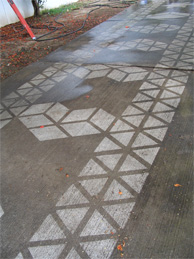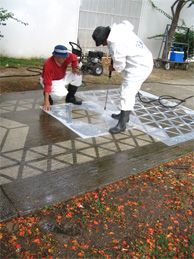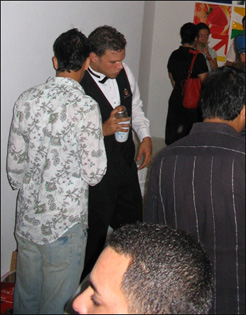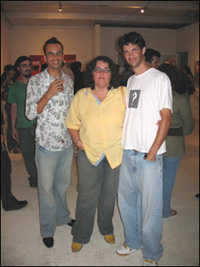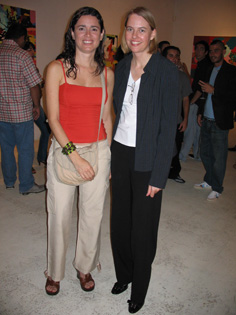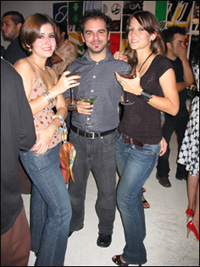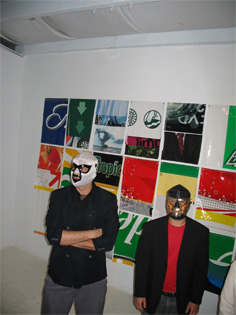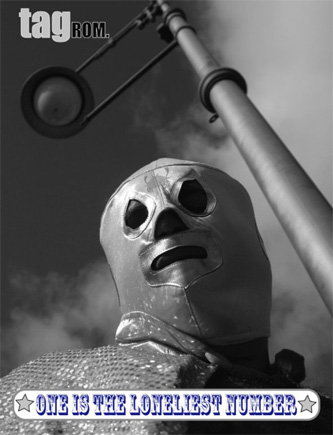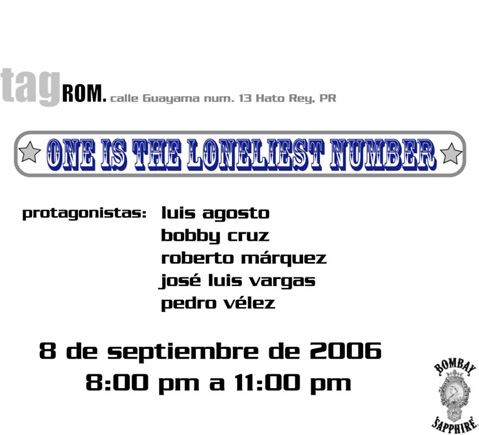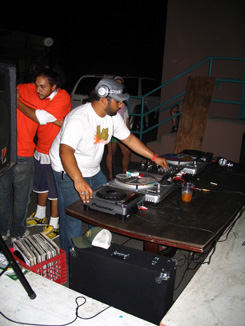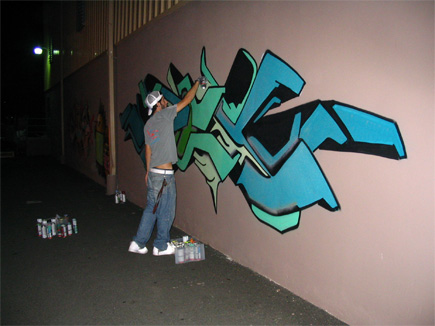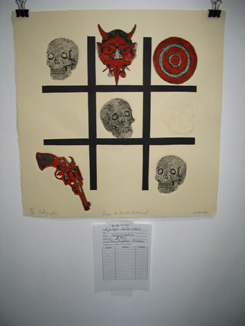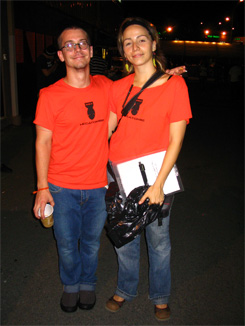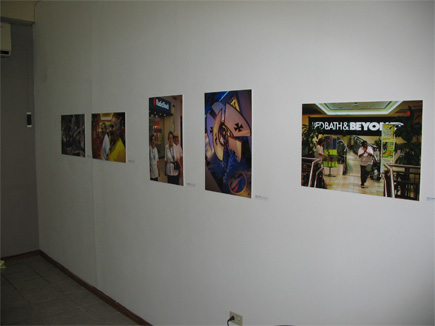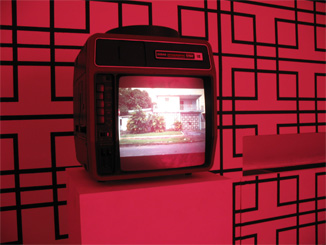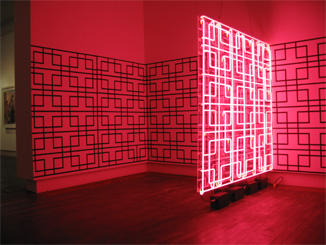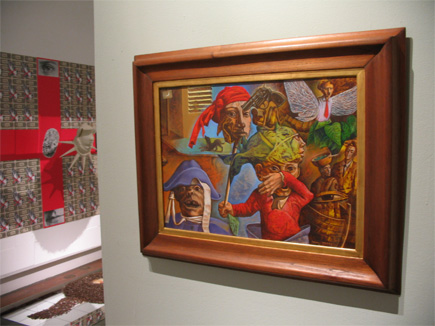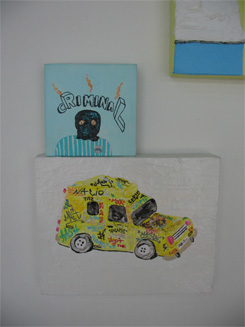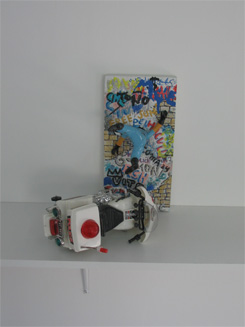|

Optika: To Tell or Not to TellOptika 2 is not a new brand of contact lenses but the name of a three-day conference in Mayagüez, Puerto Rico, on “the theory and practice of visual narrative.” Well, who doesn’t practice visual narrative, in theory at any rate? The good folks at the University of Puerto Rico in Mayagüez are inviting interested artists and academic types to mull over this and other pertinent questions for three days in February, a great time to be on the island’s fabulous west coast. But you can’t get there without knowing the details. Find those here, but do it soon. Deadline for submissions is September 25, 2006. Who Was that Masked Man?It happened last night. (Which last night? See Item One below.) The tagRom painting show opening-cum-anniversary party transpired, if not with majesty and filet mignon bits then with boozy aplomb and more bohemian pertinacity than you can shake a stick at. How does curator-co-proprietor Carlos “Chévere” Reyes do it? For one thing, as observed below, he instructs the bartender to heavily water the cosmopolitans, the better to avoid having the art work decorated with supper or snacks or the many tall-boys that may have lined the road to Calle Guayama No. 13. Good thinking, Chévere! Who’s to know, ten or twelve comos and a puzzlingly light but sufficient buzz into the evening?
The show is a good one, and you should hie yourself over to the gallery at the first opportunity. The standouts are a couple of vintage, big honkers by José Luis Vargas featuring the visage of Tonio Bicicleta in a fearsome, protozoan mode. But there is something for every discerning taste, and a little for the not so discerning. Luis Agosto-Leduc’s eye-popping wall-size installation, made of painstakingly cut and sewn sections of shiny banners, caused no end of disputatious puzzlement—certainly this is painting and certainly it isn’t—although nary a syllable was raised against the bright and breezy thing itself. But of course partying hearty has little to do with artistic excellence, and the evening was all about glad-handing, yakking, swilling down the feeble firewater, espying good-looking others, and, of course, calculating one’s place in the foodchain. The good-looking others abounded, as they seem to do in every boricua cranny, although what to make of the proximities?
In the left photo, above, from the left, Carlos Reyes, Carmen Correa, and Jason Mena. Center, Mariely López Bermúdez of Punto Gris and Cheryl Hartup, chief curator at Museo de Arte de Ponce. Right, Pedro Vélez in an uncharacteristically sunny pose, perhaps due to the company he’s keeping, Denise Miner on the left and sister Michelle on the right.
At some point in the evening el Santo de Santurce arrived with quite the posse and caused a stir. Finally. Talk about a fearsome mien. Here are a couple of el Santo’s henchpersons, who, we heard, caused no harm and, in fact, would have signed autographs if only asked. The Rotund bunch decided not to stick around and scurried away in the confusion. Noh NewsHave you ever heard the expression, “A magazine without news is the cockroach in the cupboard”? Well, neither have we, although it makes a weird kind of sense when you think about it. This Rotund episode will be the news, the whole news, and nothing but the news. No pesky “art reviews.” No half-assed stabs at “discourse.” And certainly no willy-nilly jive talk, full of show-offy, polysyllabic blather like “pusillanimous,” “chicharronear,” and “tendentious,” along with their splendidly idiotic variations: “chicharronified,” “tendentiatude,” and the like. We’ve heard the vox populi, and truthfully it sounds like coquis peeping peeping peeping peeping peeping. Enough already.
Quintín Rivera-Toro’s marathon fund-raising first anniversary party for Área, Hecatombe, was as good as its name. There was an art work auction abounding in cheapness, mucho graffiti action accompanied by DJ Ben Castro—among other groovy beats—very good street theater from Los Jovenes del 98, decent snacks por todos lados, and some horrendo grunge rock and knuckle-headed poetasting on the main stage. The parking lot next to Área resembled a hippie street fair—we mean that in the best sense of the phrase—and indeed, it was all kind of psychedelic in spirit if not in real drugs. Which is not to say that there were no controlled substances on the premises. We wouldn’t know, of course. (Clockwise from top, left: DJ Ben Castro, graffitist Dex, Quintín y Adiela, a woodcut by Christopher Rivera at the subasta muy barato.)
We had hoped to cover in some depth Jason Mena’s tightly, smartly curated group show of photography at the space he co-founded, =Desto. That is not likely to happen, but we will say that everyone’s expectations for the so-called “alternative” scene in Puerto Rico are rarely fulfilled with such conceptual distinction. The work is not all brilliantly—or even exceptionally—executed, but Mena considered each artist’s work, chose carefully, and has a great deal to say about his choices. One of the least promising selections, Alberto Meléndez’s series of shopping mall interiors, focusing on mall-walking retirees and other inhabitants of the malls’ homegrown social world, becomes, with a little study, a fascinating document of an easy-to-disdain yet eerily familiar fixture of our urban lives. Meléndez’s technique is not sophisticated—one of the reasons Mena chose him—but his eye is unerring and the scope of his project makes the work worth considering. If you stop by =Desto before September 15, you’ll likely get to see Mena's bravura performance, “F/4.” The show also includes the work of Marcial Feliciano Ramos, Venessa Hernández Gracia, and Josué Guarionex. =Desto sits at the corner of 1400 Americo Salas in Santurce. Call 787-633-3381 for an appointment. (Above, Alberto Meléndez’s photo series at =Desto.)
Speaking of easy to disdain, Museo de Arte Contemporáneo comes in for a lot of grief for its haphazard, uneven exhibition schedule, small collection, and questionable museum practices, but no institution in town has looked as good lately. Two shows opened within the last week which make a visit to MAC a must. The first is the exhibition for this year’s winners of the Lexus awards, including a very pink installation by Héctor Madera González which is a meditation on Puerto Rican residential grillwork—considerably more engaging than it sounds since its historical argument is not unconvincing and it is, in any event, prettily designed if not exactly easy on the eyes; a new series of gargantuan, pristine “Visitantes” photo collages by Carlos Ruiz Valarino, cleaner, more color-saturated, and creepier than ever, yet another step up for Ruiz Valarino; and a new, extravagantly long, exquisitely self-evident attack on capitalist excess by Quintín Rivera-Toro. Rivera-Toro is a smart guy and an excellent, valiant host—as his tenure at Área demonstrates—but something happens to his sense of proportion when he dons a pair of yellow knickers and masquerades before the camera. (Two views of Héctor Madera González's “Optical Borderline” at MAC.)
MAC’s other show also beats up on capitalism but does so in a variety of ways, through the works old and new of a dozen or so artists, including Nathan Budoff, Miguel Luciano, Arnaldo Morales, Nick Quijano, Raquel Quijano, Garvin Sierra, and Rafael Trelles. Morales’s whipping chain device is scary-looking, uncommonly clattery, and does actual harm to the steel it’s mounted on, and Trellis's paintings, spanning over twenty-five years, show that he has the consistency of a master. In fact, the whole exhibition is remarkable for how well-made the works are, some delicate and oblique in their approach to the subject, others, like Morales’s, noisy and rude. Raquel Quijano’s enormous wall panel is another of her complex objects, what we would call art black boxes: impenetrable, mysterious, yet gleaming and solid. The work for this show is a multi-panel urban landscape whose numerous technical achievements take nothing away from the simple pleasures of beholding its alternately smoky and shiny surfaces and its evocative, half-seen images. Luciano's silver-plated plantain is a hoot and a half. However thin the show's premise, we hope to give it a substantial reading proximamente. The museum is open Tuesday to Saturday, 10 a.m. to 4 p.m., and Sunday 12 to 4. It’s free to the public, and the docents are friendly and helpful. The museum is located on the corner of Avenida Juan Ponce de Leon and Avenida R.H. Todd in Santurce. For further information, call (787) 977-4030. (In the foreground, the unmistakable painting of Rafael Trelles.)
At exhausting last, the new offering at Galería Comercial, “Chochibichi loves la rue,” is another exhibition we want to spend some quality time with. “Chochibichi” is a series of pretty funny paintings by Radamés Figuroa, Junior. Figuroa, Junior has wacky fun with youthful vigor, sending motorcyle cop action figures careening into graffiti-covered brick walls—death by graffiti—and floating himself—or his doppelgänger—naked through the high atmosphere like a pink Michael Jordan about to dunk on God himself. It is hard to believe that at the turn of the twenty-first century a painter could have so much fun. Bright, bright, bright as candy and gloppy, but great figures and funny, decent jokes. Watch out for Figuroa, Junior and, better yet, watch out for painting. You can do so at Galería Commercial’s über-cool space at Fernández Juncos 1412 . Call 787-724-6460 for details. Return to yesteryear for Axis: Bold as Love here. |

